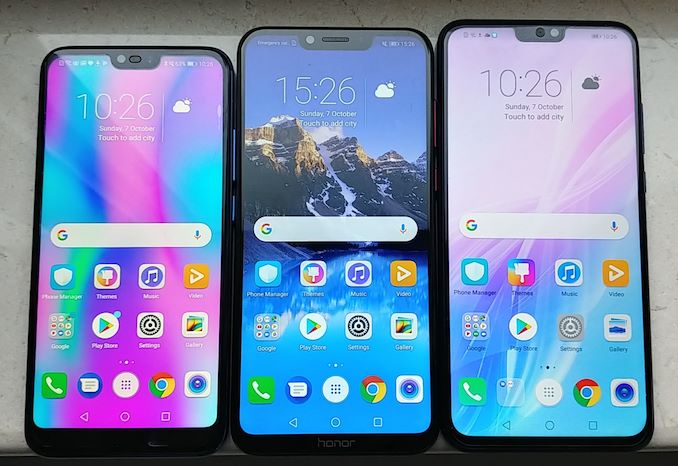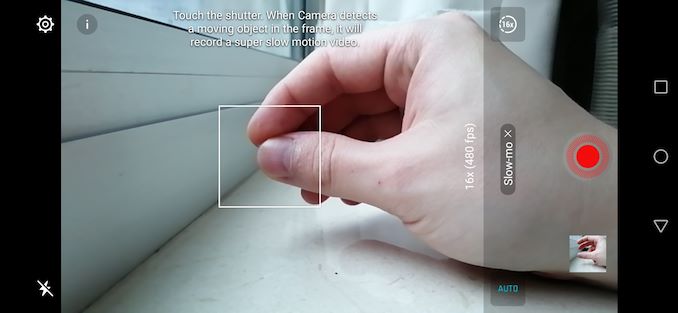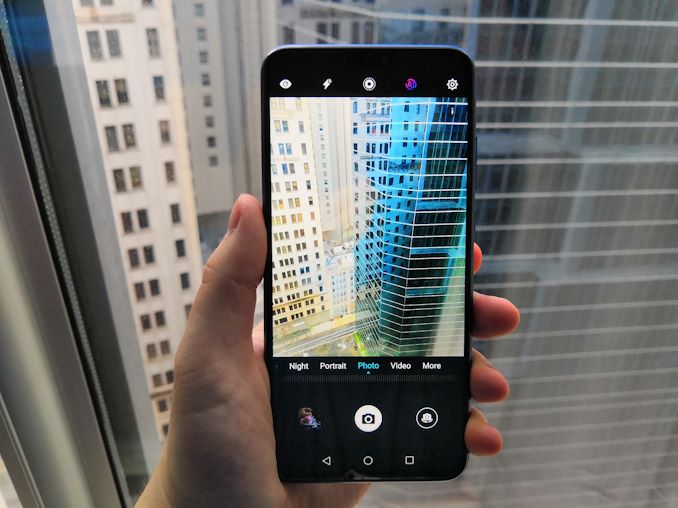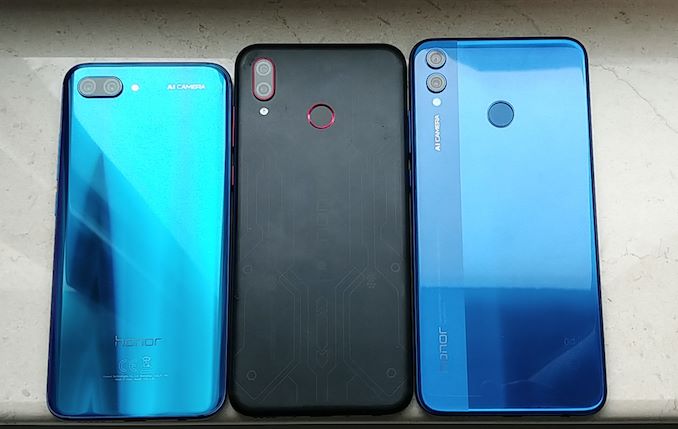Honor 8X Hands-On: 6.5-inch Best Screen-Size Per Dollar
by Ian Cutress on October 10, 2018 2:30 PM EST
Everyone is always interested in the next budget 'high-end killer' smartfone. In recent memory we've seen a number of Asian smartphone companies do it, with Flagship-like specifications always below $300. Honor's latest attempt sits at the bottom of its stack but boasts a 6.5-inch full screen display, an AI camera, and one of the latest chips inside from its big brother, Huawei.
Size Matters
Its hard to get away from the fact that the Honor 8X is a sizeable beast.
The 6.5-inch 1080p display, in a 5.5-inch class body, falls under the 'full screen' mantra that has encapsulated smartphones of late, with only a small notch and a small chin on the front being in the way of a 100 percent screen coverage. The Honor 8X comes in at 91% full screen coverage, more than pretty much every flagship, which the company states is down to its smaller chin compared to the competition:
- Honor 8X: 4.25mm
- Samsung Galaxy S9: 5.7mm
- Oneplus 6: 6.1mm
- Xiaomi Mi 8: 6.8mm
Honor doesn't state peak brightness in its materials, but does note that it can go as low as 2 nits in its eye comfort mode, and the application of eye comfort mode is certified by TUV Rheinland.
Inside the phone is the Kirin 710, Huawei's latest mid-performer SoC with four Arm Cortex A73 cores and four Arm Cortex A53 cores, combined with Mali G51MP4 graphics. The CPU portion of this chip is plenty fast, although that graphics is not going win any awards on the latest 3D smartphone titles. It will be plenty for the Candy Crush or Toon Blast crowd. Even though the chip does not have an AI accelerator like Huawei's NPU, the phone will be able to take advantage of GPU Turbo, a neural network based technology which helps lower power during certain games for the chip to turbo for longer. At current this is only two games, but will expand to six with the release of EMUI 9.0.

Left to Right: Honor 10 ($$$$), Honor Play ($$), Honor 8X ($)
Similar to the Honor Play, which sits above the 8X in the product portfolio, the 8X will have dual rear cameras and a single front facing camera in the notch area. The two rear cameras are listed as a 20MP+2MP design at f/1.8, and is supported by AI-assisted stabilisation for long exposure shots up to six seconds. The rear cameras are also AI enabled with object recognition, layer recognition, and per pixel quality adjustments designed to improve photos (I use it a lot on the Honor 10, and it works well in the vast majority of cases). In video modes, we were told that the device can record at 720p120 and 480p at 480 fps. However in our test units, the UI offers 720p at 480 fps, which is interesting.
We did a small test to see if it is a true 720p480, given that in order to do it you would normally need a DRAM-backed camera sensor. Honor were not shouting that fact from the rooftops, and with some testing we can see that the 480 fps mode is more of an interpolation mode, as it can't really deal with quick movement:
Aside from the rear cameras on the rear, there is also a fingerprint sensor and a two-tone finish.
The front camera is Honor's 'AI Selfie' camera, which is a 16MP design that supports 4-in-1 pixel combining for better low light performance. This works by taking a 2x2 square of one micron pixels and making them act like a bigger two micron pixel. The end result is a 4MP photo rather than a 16MP photo, but should offer better clarity. As one might expect, Honor also supports background replacement, AR skins, and a front facing portrait mode.
The front facing camera is in a notch, which means that users will have the notch issue. As will all Huawei and Honor devices, the area around the sides of the notch can be blacked out to make it look like there is no notch. However one thing I noticed with the 8X is how it deals with icons in that top bar: most notched phones put those icons way too close to the rounded edges, such that they can sometimes be clipped. Because the notch on the 8X is small, the icons are brought in closer to the center, making it easier to see them. If anything, it removes the issue of it not looking right when clipping happens, which I think is ultimately a good way of improving UX.
As a mid range device, the memory and storage follow similarly, at 4 GB and 64 GB, which is equal or one notch below the flagship devices (some markets will see 4GB+128GB or 6GB+128GB). The battery comes in at 3750 mAh, which is certainly a Flagship-worthy capacity, though perhaps a little small for the size of this phone. There is a 3.5mm jack, although perhaps annoyingly there is no USB Type-C: we're going back into the olden times with microUSB for the 8X. The phone also supports dual Nano SIM plus a microSD at the same time. As a frequent international traveller, this is much appreciated. Wi-Fi on most models will be 802.11ac dual band, although a couple of variants will only be 802.11n 2.4 GHz.
Other features on the device include what Honor calls 'elevator mode' to help users connect to networks more quickly. In the examples cited, their testing showed that the unit would reconnect to networks in Hong Kong within 5 seconds, while a major competitor Flagship would take between 8 and 60 seconds. Personally, with our sample, I've seen it reconnect to WiFi networks very quick, although to test this at scale requires a dedicated trip into London. Huawei says that they are using its AI to enhance connectivity speeds, though did not go into much detail. What they did state is that the antenna positioning in the device helps with this. Honor stated that rather than using a dual corner antenna like most smartphones, they use a big U shape around the bottom edge to get a better uniform connectivity regardless of the angle of the device.
| Honor 10 Series | |||||
| Honor View 10 | Honor 10 | Honor Play | Honor 8X | ||
| Models | BKL-L29 | COL-L29 | COR-L29 | JSN-L21 | |
| SoC | Name | HiSilicon Kirin 970 | HiSilicon Kirin 970 | HiSilicon Kirin 970 | HiSilicon Kirin 710 |
| CPU | 4xA73 @ 2.4GHz 4xA53 @ 1.8GHz |
4xA73 @ 2.4 GHz 4xA53 @ 1.8GHz |
4xA73 @ 2.4GHz 4xA53 @ 1.8GHz |
4xA73 @ 2.2GHz 4xA53 @ 1.7 GHz |
|
| GPU | Mali-G72MP12 | Mali G72MP12 | Mali-G72MP12 | Mali-G51MP4 | |
| Display | 5.99-inch 2160x1080 18:9 IPS LCD |
5.84-inch 2280x1080 19:9 IPS LCD |
6.3-inch 2340x1080 19.5:9 IPS LCD |
6.5-inch 2340x1080 19.5:9 IPS LCD |
|
| Size (mm) | 157.0 x 75.0 x 7.0 | 149.6 x 71.2 x 7.7 | 157 x 74.3 x 7.5 | 160.4 x 76.6 x 7.8 | |
| Mass | 172g | 153g | 176g | 175g | |
| RAM + NAND | 6GB + 128GB | 4GB+64GB 4GB+128GB |
4GB+64GB | 4GB+64GB 4GB+128GB 6GB+128GB |
|
| MicroSD | Yes | No | Yes | Yes | |
| Battery | 2750mAh | 3750mAh | 3750 mAh | 3750 mAh | |
| Front Camera | 13MP f/2.0 | 24 MP f/2.0 | 16MP F/2.0 | 16MP f/2.0 4MP mode |
|
| Rear Camera | 16MP RGB f/1.8 20MP B+W f/1.8 |
16MP RGB f/1.8 25MP B+W f/1.8 |
16MP RGB f/2.2 2MP Depth |
20MP RGB f/1.8 2MP Depth |
|
| SIM Size | 2x NanoSIM | 2x NanoSIM | 2x NanoSIM | 2x NanoSIM + microSD |
|
| Wi-Fi | 802.11ac | 80211.ac | 802.11ac | L21: 802.11ac L22: 802.11n 2.4G L23: 802.11n 2.4G L42: 802.11ac |
|
| Bluetooth | BT 4.2 LE | BT 4.2 | BT 4.2 | BT 4.2 LE | |
| Connectivity | USB 2.0 Type-C 3.5mm headset |
USB 2.0 Type-C 3.5mm headset |
USB 2.0 USB-C 3.5mm headset |
microUSB 2.0 3.5mm headset |
|
| Fingerprint | Rear | Front | Rear | Rear | |
| Launch OS | Android 8.0 with EMUI 8.0 | Android 8.1 with EMUI 8.0 | Android 8.1 with EMUI 8.2 | Android 8.1 with EMUI 8.2 | |
| Launch Price | EUR 499€ GBP £449 |
EUR 400€ | EUR 329€ GBP £279 |
GBP £239 | |
Honor has three colors for the 8X, however only two will hit the UK: Blue and Black. The more exotic red will end up in regions where there is demand. Honor held back on declaring a price, saying we will have to wait until the device launch on October 10th.
First Impressions
I have been using the phone on and off for a few days, and to be honest, I guess I'm more surprised at how easy to use I find it. I often do work on my phones - aside from emails, I write up news and reviews on them as well. I'm not sure if it's the bigger screen, or the fact that it feels snappy, but the Honor 8X is very easy to work on. The connectivity aspect, being fast to connect to access points, is a big plus when I'm on the London underground and we keep going in/out of LTE range.
I think the biggest downside is that microUSB connector. Everything portable I own, laptops included, is now USB Type-C. I have to dig out old microUSB cables for the only device with this port. The argument for having microUSB is that the market this phone is aimed at is still on microUSB, although that was the argument back when the flagships were still microUSB as well. It's a weak argument - no-one has asked to borrow a microUSB cable from me for years. Speaking with a few others who also have the device, they feel this is the biggest let down as well. The Honor Play, which is meant to cost only slightly more, has a Type-C.
Comparing side by side with the Honor Play, the 8X is a bigger device with a slower SoC - that's going to reflect in the price for sure. Where the Play is meant to be aimed at gaming, this is more of a daily workhorse. One of the features that is going to be key long term is the camera - I have already heard some other journalists complain a little, because the AI mode does help disguise some cost saving on the device. I haven't had much experience with it yet, however the slo-mo mode does work - albeit for a total of one second or so per recording. At this point I suspect the buffer is full and it cannot record any more.
The battery is reasonably big, but the device has a big screen and a good resolution, which can perhaps cancel each other out. The fact that the Kirin 710 inside uses Cortex A73 doesn't put it in the low power bracket, but the fact that the chip is built on TSMC's 12FFC does weigh in its favor.
Overall, except for the USB thing, and testing the camera a lot more, I could see this as a very dependable device for most users. The biggest win is the screen size for the price, getting suspiciously close to that traditional '7-inch Tablet' border.
Related Reading
- Honor Previews the Honor Magic 2: A No-Notch FullView Smartphone with Kirin 980
- Honor Launches £99 Honor 7S
- Honor’s Thin-and-Light MagicBook with AMD Ryzen Mobile Listed
- Top 5 in 3 Years: A Group Interview with George Zhao, Honor President
- Honor 10 Launch and Hands On: Kirin 970, More AI, More Notch
























31 Comments
View All Comments
euskalzabe - Thursday, October 11, 2018 - link
It's the main reason why I've been using Moto Es and Gs. I broke my last one a couple months ago - I always break them, thus why I buy at the $200 range - and I decided to try a Nokia 3.1. Positively surprised - amazing build and good performance for the $160 I paid. I'm much more likely now to go up to a Nokia 5.2 or whatever mid-range model they release next year, than to a Moto G7.realbabilu - Wednesday, October 10, 2018 - link
Does it have NFC?serendip - Wednesday, October 10, 2018 - link
Huawei also sells a monstrous 8X Max with a 7.1" screen, 5000 mAh battery and SD636 chip. I would rather go for this one for the long battery life and better GPU compared to the Kirin 710.davidk01 - Thursday, October 11, 2018 - link
Inside the phone is the Kirin 710, Huawei's latest mid-performer SoC with four Arm Cortex A73 cores and four Arm Cortex A53 cores, combined with Mali G51MP4 graphics. The CPU portion of this chip is plenty fast, although that graphics is not going win any awards on the latest 3D smartphone titles.duploxxx - Thursday, October 11, 2018 - link
honor device are nice from specs perspective.... but horrible EMUI.GreenReaper - Thursday, October 11, 2018 - link
You're living in a bubble, man - everything we have is microUSB, and those cables are in high demand since one of them broke. We have one Lightning iPad, too (along with a 30-pin iPad 2). Really, if it's still USB 2.0, there's little point in USB-C - you might as well retain compatibility.We also have microSD, so it's nice that they have it there. Actually, looking at the table, I was a little confused at which one was meant to be the flagship. Not quite as fast a CPU/GPU, but eh.
PeachNCream - Thursday, October 11, 2018 - link
Agreed. Ian's world of tech journalism puts him into constant contact with new hardware and detaches him from the technological realities of the rest of us. It's only been in the past 1.5 years that I've gotten my hands on computing hardware with USB 3.0 Type A ports. Everything up to 2016 was using USB 2.0 and I've yet to even physically touch any computing hardware with USB-C yet I work for a major TELCO and have a small mountain of computers and consumer electronics laying around in my home. There is indeed a big disconnect between him and us.GreenReaper - Thursday, October 11, 2018 - link
Just to put it in perspective, USB 1.1 (the first version widely used) was released in August 1998. We've had USB-A for over 20 years, mini B since 2001, and micro B since 2007. In that time people have collected a bunch of stuff that fulfils their needs.Here's the systems I personally maintain at home:
* Sony laptop (2003)
* Dell E1510/6400 laptop (2006)
* Sony all-in-one PC (2008)
* Lenovo ThinkPad (2011)
* Original Surface Pro (2013)
* HP Microsever Gen8 (2014)
All of these are still being updated and usable (although I wouldn't want to use the 2003 laptop all the time), thanks in part to Microsoft's patches for POSReady 2009 (works on XP) and Windows Server 2008 (Vista). In fact, thanks to Microsoft's drive to get us onto it, most can run Windows 10.
*None* have USB-C - the only ones with USB 3.0 ports are the Surface Pro and the MicroServer. My brother's XPS 15 (2017) *does* have a USB-C port. but I don't think he uses it yet. So if I bought a USB-C phone, I'd instantly need some kind of adaptor to plug it in to any of them.
The actual need for USB-C on a mobile is limited. It's not like they need the increased bandwidth - heck, they're all running USB 2.0 over it. It's size, possibly power delivery, and sheer newness. So micro B ports might well be a selling point - if nothing else, the battery boat plugs straight in with existing cables.
[And as for the wider issue of USB-A ports on laptops: think of all the accessories! We have USB 2.0 scanners/printers (2007), digital cameras, phones (various years from 2001 onwards), mobile battery boat and a SoundCore speaker (both bought in 2018), DisplayLink DL-165-based USB video dongle (2009 tech, bought new in 2017, because I knew the USB 2.0-only one worked in Linux, and the Thinkpad only had USB 2.0 - it was also the cheapest), ColorMunki Display colorimiter (2011, bought in 2018), Xbox One and Steam controllers (2017), U2F security dongle (2017), mice, keyboards, webcams (2001, 2002), numerous USB flash keys and wall chargers...]
timecop1818 - Thursday, October 11, 2018 - link
USB-C to A cables do exist and (in case of Huawei) are included in the box. The connector itself is far superior to micro b in reliability/strength/insertion count/usability. Discarding it just because you hoard a bunch of ancient hardware is honestly pretty silly.Not to mention with properly implemented USB-C you can use phone to charge other devices, output Displayport to monitors/etc, use cheap C to A/HDMI/etc hubs, the list of benefits goes on and on. And if you're a luddite, just use the included C to A cable and forget the type of port you got there.
GreenReaper - Friday, October 12, 2018 - link
I'm doubt you'll to be able to do most of those things in this case because the USB-C is just being used as a path for USB 2.0 and power. It *might* charge a bit faster, but that isn't stated here.I'm not at all opposed to USB-C being used where it's useful. I'd look for it in a new PC with Type-A. In this case, Honor has correctly determined that it'd be a bit of a pain for the target audience.